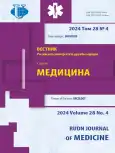Distribution of β-amyloid and pTau in brain cortex depending on age and mental state
- Autores: Sentyabreva A.V.1,2, Vasyukova O.A.1, Zorkina Y.A.3,4, Andryuschenko A.V.3,5, Kostyuk G.P.3,6,7, Eremina I.Z.2, Kosyreva A.M.1,2
-
Afiliações:
- Avtsyn Research Institute of Human Morphology of “Petrovsky National Research Centre of Surgery”
- RUDN University
- Alekseev Psychiatric Clinical Hospital No. 1
- Serbsky National Medical Research Center for Psychiatry and Narcology
- Lomonosov Moscow State University
- Russian Biotechnological University (ROSBIOTECH)
- Sklifosovsky Institute of Clinical Medicine, Sechenov University
- Edição: Volume 28, Nº 4 (2024): ONCOLOGY
- Páginas: 488-498
- Seção: HISTOLOGY
- URL: https://journal-vniispk.ru/2313-0245/article/view/319740
- DOI: https://doi.org/10.22363/2313-0245-2024-28-4-488-498
- EDN: https://elibrary.ru/GZKOCG
- ID: 319740
Citar
Texto integral
Resumo
Relevance. Alzheimer’s disease (AD) is the most cause of disability and dementia, which is the 7th leading cause of death worldwide. Diagnosis of AD includes detection of amyloid plaques and hyperphosphorylated tau protein (pTau) in the brain. However, in recent years the amyloid hypothesis of AD development has been criticized and revised, and a growing pool of data emerges indicating more complex pathogenetic mechanisms leading to neurodegeneration in AD. The aim of our work was to evaluate the presence and distribution of amyloid plaques and pTau fragments in different regions of the cerebral cortex in patients > 60 years old with diagnosed dementia and without cognitive impairment, as well as in people < 60 years old. Materials and Methods. The amount of β-amyloid and pTau fragments in three groups of patients was measured on IHC stained histological sections in the regions of parahippocampal, temporal, and occipital cortex. Results and Discussion. Amyloid plaques were detected in all patients over 60 years of age (with and without dementia), while in younger individuals 60 years of age they were found in 66% of cases. The largest amyloid-β burden was observed in the occipital cortex. pTau was detected in all cortical areas in the three groups of patients. Also, the amount of pTau was higher in the occipital cortex in patients over 60 years of age both with and without dementia than in the group of people under 60 years of age. Conclusion. Thus, accumulation of pTau occurs earlier than β-amyloid. The amount of pTau was higher in patients over 60 years of age with clinically manifested dementia, while in some regions the amount of amyloid conglomerates is higher in cognitively intact patients. The findings point to much more complex mechanisms of the neurodegenerative diseases development with the formation of amyloid plaques being a consequence rather than cause of the disease.
Palavras-chave
Sobre autores
Alexandra Sentyabreva
Avtsyn Research Institute of Human Morphology of “Petrovsky National Research Centre of Surgery”; RUDN University
Autor responsável pela correspondência
Email: alexandraasentyabreva@gmail.com
ORCID ID: 0000-0001-5064-219X
Código SPIN: 6966-9959
Moscow, Russian Federation
Olyesya Vasyukova
Avtsyn Research Institute of Human Morphology of “Petrovsky National Research Centre of Surgery”
Email: alexandraasentyabreva@gmail.com
ORCID ID: 0000-0001-6068-7009
Código SPIN: 2242-0958
Moscow, Russian Federation
Yana Zorkina
Alekseev Psychiatric Clinical Hospital No. 1; Serbsky National Medical Research Center for Psychiatry and Narcology
Email: alexandraasentyabreva@gmail.com
ORCID ID: 0000-0003-0247-2717
Código SPIN: 3017-3328
Moscow, Russian Federation
Alisa Andryuschenko
Alekseev Psychiatric Clinical Hospital No. 1; Lomonosov Moscow State University
Email: alexandraasentyabreva@gmail.com
ORCID ID: 0000-0002-7702-6343
Código SPIN: 8864-3341
Moscow, Russian Federation
Georgy Kostyuk
Alekseev Psychiatric Clinical Hospital No. 1; Russian Biotechnological University (ROSBIOTECH); Sklifosovsky Institute of Clinical Medicine, Sechenov University
Email: alexandraasentyabreva@gmail.com
ORCID ID: 0000-0002-3073-6305
Código SPIN: 3424-4544
Moscow, Russian Federation
Irina Eremina
RUDN University
Email: alexandraasentyabreva@gmail.com
ORCID ID: 0000-0002-5093-6232
Código SPIN: 5819-6159
Moscow, Russian Federation
Anna Kosyreva
Avtsyn Research Institute of Human Morphology of “Petrovsky National Research Centre of Surgery”; RUDN University
Email: alexandraasentyabreva@gmail.com
ORCID ID: 0000-0002-6182-1799
Código SPIN: 5421-5520
Moscow, Russian Federation
Bibliografia
- The top 10 causes of death. WHO. 2020. Available at: https://www.who.int/news-room/fact-sheets/detail/the-top‑10‑causes-of-death [Accessed on 2024 February 12].
- Federal Law of 21.11.2011 № 323-FZ “On the basis of the healthcare of citizens in the Russian Federation” (in Russian).
- Vatolina M. The problems of evaluation of mortality of Alzheimer’s disease in Russia. Zdravookhraneniye Rossiyskoy Federatsii. 2015;59(4):20—24. (in Russian).
- Haque SS. Biomarkers in the diagnosis of neurodegenerative diseases. RUDN Journal of Medicine. 2022;26(4):431—440. doi: 10.22363/2313-0245-2022-26-4-431-440
- Vasenina E, Levin O, Sonin A. Modern trends in epidemiology of dementia and management of patients with cognitive impairment. Zhurnal nevrologii i psikhiatrii imeni S.S. Korsakova. 2017;117(6—2):87—95. (in Russian).
- Tkacheva ON, Yakhno NN, Neznanov NG, Levin OS, Gusev EI. Cognitive disorders in elderly and senile people. Clinical recommendations. M., 2020. 317 p. (in Russian).
- Hardy JA, Higgins GA. Alzheimer’s disease: the amyloid cascade hypothesis. Science. 1992;256(5054):184—185. doi: 10.1126/science.1566067
- Hyman BT, Phelps CH, Beach TG, et al. National Institute on Aging-Alzheimer’s Association guidelines for the neuropathologic assessment of Alzheimer’s disease. Alzheimer’s & dementia: the journal of the Alzheimer’s Association. 2012;8(1):1—13. doi: 10.1016/j.jalz.2011.10.007
- Whittington A, Sharp DJ, Gunn RN; Alzheimer’s Disease Neuroimaging Initiative. Spatiotemporal Distribution of β-Amyloid in Alzheimer Disease Is the Result of Heterogeneous Regional Carrying Capacities. Journal of Nuclear Medicine. 2018;59(5):822—827. doi: 10.2967/jnumed.117.194720
- Braak H, Braak E. Neuropathological stageing of Alzheimer-related changes. Acta Neuropathologica. 1991;82(4):239—259. doi: 10.1007/BF00308809
- Thal DR, Rüb U, Orantes M, Braak H. Phases of A beta-deposition in the human brain and its relevance for the development of AD. Neurology. 2002;58(12):1791—1800. doi: 10.1212/wnl.58.12.1791
- Braak H, Thal DR, Ghebremedhin E, Del Tredici K. Stages of the pathologic process in Alzheimer disease: age categories from 1 to 100 years. Journal of Neuropathology & Experimental Neurology. 2011;70(11):960—969. doi: 10.1097/NEN.0b013e318232a379
- Braak H, Del Tredici K. The pathological process underlying Alzheimer’s disease in individuals under thirty. Acta Neuropathologica. 2011;121(2):171—181. doi: 10.1007/s00401-010-0789-4
- Franceschi C, Campisi J. Chronic inflammation (inflammaging) and its potential contribution to age-associated diseases. The journals of gerontology. Series A, Biological sciences and medical sciences. 2014;69 Suppl 1: S4-S9. doi: 10.1093/gerona/glu057
- Dementia. WHO. 2023. Available at: https://www.who.int/news-room/fact-sheets/detail/dementia. [Accessed 2024 March 2].
- Kosyreva AM, Sentyabreva AV, Tsvetkov IS, Makarova OV. Alzheimer’s Disease and Inflammaging. Brain Science. 2022;12(9):1237. doi: 10.3390/brainsci12091237
- Müller N. Inflammation in Schizophrenia: Pathogenetic Aspects and Therapeutic Considerations. Schizophrenia Bulletin. 2018;44(5):973—982. doi: 10.1093/schbul/sby024
Arquivos suplementares









